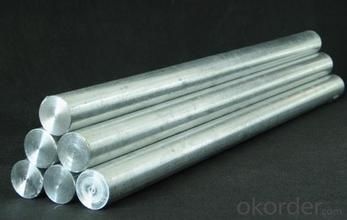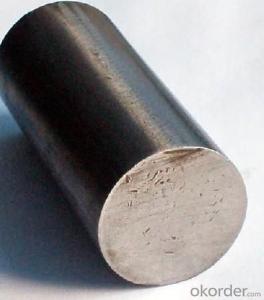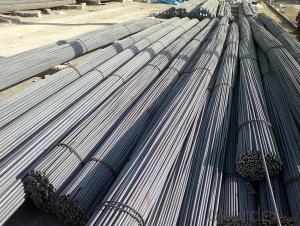Special Steel Round Bar
- Loading Port:
- China Main Port
- Payment Terms:
- TT or LC
- Min Order Qty:
- -
- Supply Capability:
- -
OKorder Service Pledge
OKorder Financial Service
You Might Also Like
Product Description:
OKorder is offering Special Steel Round Bar at great prices with worldwide shipping. Our supplier is a world-class manufacturer of steel, with our products utilized the world over. OKorder annually supplies products to European, North American and Asian markets. We provide quotations within 24 hours of receiving an inquiry and guarantee competitive prices.
Product Applications:
Special Steel Round Bar are ideal for structural applications and are widely used in the construction of buildings and bridges, and the manufacturing, petrochemical, and transportation industries.
Product Advantages:
OKorder's Special Steel Round Bar are durable, strong, and resist corrosion.
Main Product Features:
· Premium quality
· Prompt delivery & seaworthy packing (30 days after receiving deposit)
· Corrosion resistance
· Can be recycled and reused
· Mill test certification
· Professional Service
· Competitive pricing
Product Specifications:
Manufacture: Hot rolled
Grade: Q195 – 235
Certificates: ISO, SGS, BV, CIQ
Length: 6m – 12m, as per customer request
Packaging: Export packing, nude packing, bundled
Chinese Standard (H*W*T) | Weight (Kg/m) | 6m (pcs/ton) | Light I (H*W*T) | Weight (Kg/m) | 6m (pcs/ton) | Light II (H*W*T) | Weight (Kg/m) | 6M |
100*68*4.5 | 11.261 | 14.8 | 100*66*4.3 | 10.13 | 16.4 | 100*64*4 | 8.45 | 19.7 |
120*74*5.0 | 13.987 | 11.9 | 120*72*4.8 | 12.59 | 13.2 | 120*70*4.5 | 10.49 | 15.8 |
140*80*5.5 | 16.89 | 9.8 | 140*78*5.3 | 15.2 | 10.9 | 140*76*5 | 12.67 | 13.1 |
160*88*6 | 20.513 | 8.1 | 160*86*5.8 | 18.46 | 9 | 160*84*5.5 | 15.38 | 10.8 |
180*94*6.5 | 24.143 | 6.9 | 180*92*6.3 | 21.73 | 7.6 | 180*90*6 | 18.11 | 9.2 |
200*100*7 | 27.929 | 5.9 | 200*98*6.8 | 25.14 | 6.6 | 200*96*6.5 | 20.95 | 7.9 |
220*110*7.5 | 33.07 | 5 | 220*108*7.3 | 29.76 | 5.6 | 220*106*7 | 24.8 | 6.7 |
250*116*8 | 38.105 | 4.3 | 250*114*7.8 | 34.29 | 4.8 | 250*112*7.5 | 28.58 | 5.8 |
280*122*8.5 | 43.492 | 3.8 | 280*120*8.2 | 39.14 | 4.2 | 280*120*8 | 36.97 | 4.5 |
300*126*9 | 48.084 | 3.4 | 300*124*9.2 | 43.28 | 3.8 | 300*124*8.5 | 40.87 | 4 |
320*130*9.5 | 52.717 | 3.1 | 320*127*9.2 | 48.5 | 3.4 | |||
360*136*10 | 60.037 | 2.7 | 360*132*9.5 | 55.23 | 3 |
FAQ:
Q1: Why buy Materials & Equipment from OKorder.com?
A1: All products offered byOKorder.com are carefully selected from China's most reliable manufacturing enterprises. Through its ISO certifications, OKorder.com adheres to the highest standards and a commitment to supply chain safety and customer satisfaction.
Q2: How do we guarantee the quality of our products?
A2: We have established an advanced quality management system which conducts strict quality tests at every step, from raw materials to the final product. At the same time, we provide extensive follow-up service assurances as required.
Q3: How soon can we receive the product after purchase?
A3: Within three days of placing an order, we will begin production. The specific shipping date is dependent upon international and government factors, but is typically 7 to 10 workdays.
Q4: What makes stainless steel stainless?
A4: Stainless steel must contain at least 10.5 % chromium. It is this element that reacts with the oxygen in the air to form a complex chrome-oxide surface layer that is invisible but strong enough to prevent further oxygen from "staining" (rusting) the surface. Higher levels of chromium and the addition of other alloying elements such as nickel and molybdenum enhance this surface layer and improve the corrosion resistance of the stainless material.
Q5: Can stainless steel rust?
A5: Stainless does not "rust" as you think of regular steel rusting with a red oxide on the surface that flakes off. If you see red rust it is probably due to some iron particles that have contaminated the surface of the stainless steel and it is these iron particles that are rusting. Look at the source of the rusting and see if you can remove it from the surface.
Images:


- Q:Can steel round bars be used for making suspension springs?
- Certainly! Suspension springs can indeed be made using steel round bars. The reason steel is often chosen as the material for suspension springs is because of its exceptional strength and durability. By forging or shaping the round bars into the desired spring shape, and subsequently subjecting them to heat treatment, the desired spring characteristics can be achieved. Moreover, steel round bars can be effortlessly machined and drilled to accommodate various suspension systems and components. Nevertheless, it is crucial to carefully consider the specific requirements and load capacity of the suspension system, in order to ensure that the selected steel round bars are appropriate for the intended application.
- Q:What is the difference between hot rolled and cold drawn steel round bars?
- Hot rolled steel round bars undergo the process of heating a steel billet or ingot at a high temperature and subsequently rolling it into the desired shape. This process yields a rougher surface finish and a greater diameter tolerance in comparison to cold drawn steel round bars. The usage of hot rolled bars is frequently found in areas where strength and durability hold significance, such as in construction and manufacturing. On the contrary, cold drawn steel round bars are created by pulling a hot rolled bar through a die at room temperature, leading to a smoother surface finish and tighter diameter tolerances. This procedure also enhances the mechanical properties of the steel, including its strength and hardness. Cold drawn bars are often employed in scenarios where precision and a high-quality surface finish are prerequisites, like in the production of shafts, bolts, and precision components. To summarize, the principal disparities between hot rolled and cold drawn steel round bars encompass the surface finish, diameter tolerance, and mechanical properties. Hot rolled bars bear a rougher surface finish, larger diameter tolerances, and are typically utilized in contexts where strength and durability are paramount. Cold drawn bars possess a smoother surface finish, tighter diameter tolerances, and are commonly employed in situations necessitating precision and a high-quality surface finish.
- Q:Can steel round bars be painted or coated?
- Steel round bars can indeed be painted or coated, which is a widely adopted practice aimed at enhancing their appearance, safeguarding them against corrosion, and offering added functionality. Typically, this process involves thoroughly cleaning the bars' surface to eliminate any dirt, grease, or rust, and subsequently applying a primer or base coat, followed by a topcoat or finish. The choice of paint or coating relies on the particular requirements of the application, such as desired color, level of protection, or resistance to environmental conditions. Moreover, specific coatings can confer distinct properties, such as anti-slip, heat resistance, or chemical resistance. In general, painting or coating steel round bars proves to be an effective means of augmenting their aesthetics and durability.
- Q:What are the cost considerations for steel round bars?
- Cost considerations for steel round bars can vary depending on several factors. Firstly, the type and grade of steel used in the production of the round bars can greatly impact the cost. Different types of steel, such as carbon steel, alloy steel, or stainless steel, have varying costs due to differences in their composition and properties. Higher grade steel with superior strength and durability will generally be more expensive than lower grade options. Secondly, the size and dimensions of the round bars will also affect the cost. Larger diameter and length of the bars will require more raw material and additional processing, resulting in higher costs. Additionally, specialized shapes or custom sizes may require extra manufacturing steps or tooling, which can increase the overall price. The quantity or volume of round bars ordered can also influence the cost. Bulk orders typically benefit from economies of scale, allowing for reduced unit costs. Furthermore, longer-term contracts or partnerships with suppliers can result in better pricing agreements. Transportation and logistics expenses should also be taken into account. The cost of shipping steel round bars can vary depending on the distance, mode of transportation, and handling requirements. International shipping, for instance, may involve additional customs duties and taxes. Lastly, market conditions and fluctuations in the steel industry can impact the cost of round bars. Factors such as supply and demand, raw material costs, and currency exchange rates can all influence the final price. It is important to stay updated with market trends and work closely with suppliers to negotiate favorable pricing. Considering these various factors, it is crucial to conduct thorough research, compare quotes from multiple suppliers, and evaluate the quality-to-price ratio before making a decision. This will help ensure that the cost of steel round bars aligns with your budget and meets your specific requirements.
- Q:Are steel round bars suitable for high-pressure applications?
- Steel round bars are frequently a good choice for high-pressure applications. Steel is renowned for its strength and durability, making it an ideal material for handling high pressure. Round bars, in particular, possess exceptional tensile strength and resistance to deformation, rendering them suitable for utilization in high-pressure settings like hydraulic systems, oil and gas pipelines, and structural applications. Furthermore, steel round bars can be customized to meet specific strength and hardness criteria, further enhancing their aptness for high-pressure applications. Nevertheless, it is crucial to carefully consider the requirements of the particular application and seek advice from an engineer or industry expert to guarantee the selection of the most appropriate grade and size of steel round bar for optimal performance and safety.
- Q:Can steel round bars be threaded or machined?
- Steel round bars are capable of being threaded or machined. Threading involves the creation of internal or external threads on the surface of a steel round bar, enabling it to connect or fasten to other components. Meanwhile, machining entails the utilization of diverse cutting tools and techniques to eliminate material from the steel round bar, thereby shaping it into the desired form or size. Consequently, both threading and machining can be employed on steel round bars to fulfill specific requirements and applications, including the production of threaded rods, bolts, or customized components.
- Q:Can steel round bars be coated with protective coatings?
- Yes, steel round bars can be coated with protective coatings. These coatings serve as a barrier to protect the steel from corrosion, abrasion, and other forms of damage. The most common type of protective coating used on steel round bars is called a corrosion-resistant coating. This coating is typically applied through processes such as hot-dip galvanizing, electroplating, or powder coating. These coatings provide a layer of protection that prevents the steel from coming into contact with corrosive substances, moisture, and other environmental factors that may cause deterioration. Additionally, protective coatings can also enhance the appearance of the steel round bars and increase their lifespan.
- Q:What is the carbon content in steel round bars?
- The amount of carbon in steel round bars varies depending on the grade and type of steel utilized, causing the carbon content in carbon steel round bars to typically range from 0.08% to 1.5%. A higher carbon content grants greater strength and hardness, albeit at the expense of weldability and ductility. The customer can specify the precise carbon content during the manufacturing process, tailoring it to their desired mechanical properties and application needs.
- Q:What are the different grades of tool steel round bars?
- There are several different grades of tool steel round bars, including A2, D2, O1, S7, and H13. Each grade has its own unique properties and is suitable for specific applications in the manufacturing and machining industries.
- Q:What are the advantages of using steel round bars?
- There are several advantages to using steel round bars. Firstly, steel round bars have high strength and durability, making them suitable for various applications that require structural integrity and resistance to wear and tear. Secondly, steel round bars offer excellent machinability, allowing for easy shaping and customization according to specific project requirements. Additionally, steel round bars have a high load-bearing capacity, making them an ideal choice for heavy-duty applications such as construction and manufacturing. Lastly, steel round bars have good corrosion resistance, making them suitable for outdoor and marine environments where exposure to moisture and harsh conditions is common.
1. Manufacturer Overview |
|
|---|---|
| Location | |
| Year Established | |
| Annual Output Value | |
| Main Markets | |
| Company Certifications | |
2. Manufacturer Certificates |
|
|---|---|
| a) Certification Name | |
| Range | |
| Reference | |
| Validity Period | |
3. Manufacturer Capability |
|
|---|---|
| a)Trade Capacity | |
| Nearest Port | |
| Export Percentage | |
| No.of Employees in Trade Department | |
| Language Spoken: | |
| b)Factory Information | |
| Factory Size: | |
| No. of Production Lines | |
| Contract Manufacturing | |
| Product Price Range | |
Send your message to us
Special Steel Round Bar
- Loading Port:
- China Main Port
- Payment Terms:
- TT or LC
- Min Order Qty:
- -
- Supply Capability:
- -
OKorder Service Pledge
OKorder Financial Service
Similar products
New products
Hot products
Hot Searches
Related keywords






























